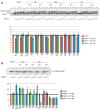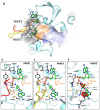Design, Synthesis and Molecular Modeling Study of Conjugates of ADP and Morpholino Nucleosides as A Novel Class of Inhibitors of PARP-1, PARP-2 and PARP-3
- PMID: 31892271
- PMCID: PMC6982223
- DOI: 10.3390/ijms21010214
Design, Synthesis and Molecular Modeling Study of Conjugates of ADP and Morpholino Nucleosides as A Novel Class of Inhibitors of PARP-1, PARP-2 and PARP-3
Abstract
We report on the design, synthesis and molecular modeling study of conjugates of adenosine diphosphate (ADP) and morpholino nucleosides as potential selective inhibitors of poly(ADP-ribose)polymerases-1, 2 and 3. Sixteen dinucleoside pyrophosphates containing natural heterocyclic bases as well as 5-haloganeted pyrimidines, and mimicking a main substrate of these enzymes, nicotinamide adenine dinucleotide (NAD+)-molecule, have been synthesized in a high yield. Morpholino nucleosides have been tethered to the β-phosphate of ADP via a phosphoester or phosphoramide bond. Screening of the inhibiting properties of these derivatives on the autopoly(ADP-ribosyl)ation of PARP-1 and PARP-2 has shown that the effect depends upon the type of nucleobase as well as on the linkage between ADP and morpholino nucleoside. The 5-iodination of uracil and the introduction of the P-N bond in NAD+-mimetics have shown to increase inhibition properties. Structural modeling suggested that the P-N bond can stabilize the pyrophosphate group in active conformation due to the formation of an intramolecular hydrogen bond. The most active NAD+ analog against PARP-1 contained 5-iodouracil 2'-aminomethylmorpholino nucleoside with IC50 126 ± 6 μM, while in the case of PARP-2 it was adenine 2'-aminomethylmorpholino nucleoside (IC50 63 ± 10 μM). In silico analysis revealed that thymine and uracil-based NAD+ analogs were recognized as the NAD+-analog that targets the nicotinamide binding site. On the contrary, the adenine 2'-aminomethylmorpholino nucleoside-based NAD+ analogs were predicted to identify as PAR-analogs that target the acceptor binding site of PARP-2, representing a novel molecular mechanism for selective PARP inhibition. This discovery opens a new avenue for the rational design of PARP-1/2 specific inhibitors.
Keywords: DNA repair; NAD+ analogs; PARP; molecular modeling; morpholino nucleosides.
Conflict of interest statement
The authors declare no conflict of interest.
Figures










Similar articles
-
Aminomethylmorpholino Nucleosides as Novel Inhibitors of PARP1 and PARP2: Experimental and Molecular Modeling Analyses of Their Selectivity and Mechanism of Action.Int J Mol Sci. 2024 Nov 22;25(23):12526. doi: 10.3390/ijms252312526. Int J Mol Sci. 2024. PMID: 39684238 Free PMC article.
-
Poly(ADP-ribose) Polymerase (PARP) and PARP Inhibitors: Mechanisms of Action and Role in Cardiovascular Disorders.Cardiovasc Toxicol. 2018 Dec;18(6):493-506. doi: 10.1007/s12012-018-9462-2. Cardiovasc Toxicol. 2018. PMID: 29968072 Review.
-
Chemical genetic discovery of PARP targets reveals a role for PARP-1 in transcription elongation.Science. 2016 Jul 1;353(6294):45-50. doi: 10.1126/science.aaf7865. Epub 2016 Jun 2. Science. 2016. PMID: 27256882 Free PMC article.
-
Using Clickable NAD+ Analogs to Label Substrate Proteins of PARPs.Methods Mol Biol. 2017;1608:95-109. doi: 10.1007/978-1-4939-6993-7_8. Methods Mol Biol. 2017. PMID: 28695506
-
Structure and function of poly(ADP-ribose) polymerase-1: role in oxidative stress-related pathologies.Curr Vasc Pharmacol. 2005 Jul;3(3):209-14. doi: 10.2174/1570161054368625. Curr Vasc Pharmacol. 2005. PMID: 16026317 Review.
Cited by
-
Comparative differential cytotoxicity of clinically used SERMs in human cancer lines of different origin and its predictive molecular docking studies of key target genes involved in cancer progression and treatment responses.Curr Res Pharmacol Drug Discov. 2021 Dec 31;3:100080. doi: 10.1016/j.crphar.2021.100080. eCollection 2022. Curr Res Pharmacol Drug Discov. 2021. PMID: 35059624 Free PMC article.
-
Design of the New Closo-Dodecarborate-Containing Gemcitabine Analogue for the Albumin-Based Theranostics Composition.Molecules. 2023 Mar 15;28(6):2672. doi: 10.3390/molecules28062672. Molecules. 2023. PMID: 36985644 Free PMC article.
-
Inhibition of DNA Repair Enzymes as a Valuable Pharmaceutical Approach.Int J Mol Sci. 2023 Apr 27;24(9):7954. doi: 10.3390/ijms24097954. Int J Mol Sci. 2023. PMID: 37175662 Free PMC article.
-
Poly(ADP-Ribosyl) Code Functions.Acta Naturae. 2021 Apr-Jun;13(2):58-69. doi: 10.32607/actanaturae.11089. Acta Naturae. 2021. PMID: 34377556 Free PMC article.
-
New Hybrid Compounds Combining Fragments of Usnic Acid and Thioether Are Inhibitors of Human Enzymes TDP1, TDP2 and PARP1.Int J Mol Sci. 2021 Oct 20;22(21):11336. doi: 10.3390/ijms222111336. Int J Mol Sci. 2021. PMID: 34768766 Free PMC article.
References
-
- Talhaoui I., Lebedeva N.A., Zarkovic G., Saint-Pierre C., Kutuzov M.M., Sukhanova M.V., Matkarimov B.T., Gasparutto D., Saparbaev M.K., Lavrik O.I., et al. Poly(ADP-ribose) polymerases covalently modify strand break termini in DNA fragments in vitro. Nucleic Acids Res. 2016;44:9279–9295. - PMC - PubMed
MeSH terms
Substances
Grants and funding
LinkOut - more resources
Full Text Sources
Miscellaneous

